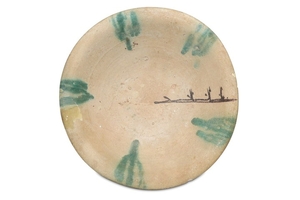A COPPER GREEN-SPLASHED POTTERY BOWL Possibly Nishapur, Iran,...
A COPPER GREEN-SPLASHED POTTERY BOWL
Possibly Nishapur, Iran, 9th – 10th century
Of hemispherical shape, with rounded everted rim, on a short circular foot, a deep cavetto, the body covered in opaque white glaze and painted with five copper green splashes on the rim and an unreadable inscription in manganese, 20cm diam. Accompanied by a thermoluminescence analysis report at Oxford Authentication centre, sample no. N118s80.
Provenance: Private UK collection, purchased in Iran in the late 1960s, thence in the family by descent.
Opaque white-glazed wares are probably the most quintessential example of Abbasid ceramics surviving to this day. Their production started in Iraq, most precisely in Basra, around the late 8th – early 9th century and it expanded further to Syria and Iran. Scholars have agreed that the inspirational spark derived from Chinese imported porcelain bowls, which were incredibly sought-after at the time. Indeed, early examples of this pottery meticulously copy the form and design of Chinese wares. The most widespread decorative technique in this production is to paint ceramics in copper green with either splashes or rows of dots, which is also typical of Chinese wares of the Tang period.
Our lot shows a striking resemblance with a bowl at the Kuwait National Museum (CAT.D.7 – LNS 1028 C), which Oliver Watson ascribes to the Iranian production of opaque white-glazed wares. Indeed, he believes that this bowl exemplifies a more “provincial” version of the Basran original, itself copying a Chinese original. However, unlike the Chinese and the Basran version, the Iranian bowl has a flat unglazed base typical of Eastern slipwares, as our bowl has. The radial inscription is intended to give the impression of writing, but is actually unreadable. Similar inscription might have been the inspiration for the Nishapuri slip-painted ‘calligraphic’ wares, so popular in the 10th and 11th century (O. Watson, Ceramics from Islamic Lands, Thames and Hudson and The al-Sabah Collection, Kuwait National Museum, 2004, chapter D, pp. 171 – 176).
View it on
Estimate
Time, Location
Auction House
A COPPER GREEN-SPLASHED POTTERY BOWL
Possibly Nishapur, Iran, 9th – 10th century
Of hemispherical shape, with rounded everted rim, on a short circular foot, a deep cavetto, the body covered in opaque white glaze and painted with five copper green splashes on the rim and an unreadable inscription in manganese, 20cm diam. Accompanied by a thermoluminescence analysis report at Oxford Authentication centre, sample no. N118s80.
Provenance: Private UK collection, purchased in Iran in the late 1960s, thence in the family by descent.
Opaque white-glazed wares are probably the most quintessential example of Abbasid ceramics surviving to this day. Their production started in Iraq, most precisely in Basra, around the late 8th – early 9th century and it expanded further to Syria and Iran. Scholars have agreed that the inspirational spark derived from Chinese imported porcelain bowls, which were incredibly sought-after at the time. Indeed, early examples of this pottery meticulously copy the form and design of Chinese wares. The most widespread decorative technique in this production is to paint ceramics in copper green with either splashes or rows of dots, which is also typical of Chinese wares of the Tang period.
Our lot shows a striking resemblance with a bowl at the Kuwait National Museum (CAT.D.7 – LNS 1028 C), which Oliver Watson ascribes to the Iranian production of opaque white-glazed wares. Indeed, he believes that this bowl exemplifies a more “provincial” version of the Basran original, itself copying a Chinese original. However, unlike the Chinese and the Basran version, the Iranian bowl has a flat unglazed base typical of Eastern slipwares, as our bowl has. The radial inscription is intended to give the impression of writing, but is actually unreadable. Similar inscription might have been the inspiration for the Nishapuri slip-painted ‘calligraphic’ wares, so popular in the 10th and 11th century (O. Watson, Ceramics from Islamic Lands, Thames and Hudson and The al-Sabah Collection, Kuwait National Museum, 2004, chapter D, pp. 171 – 176).



